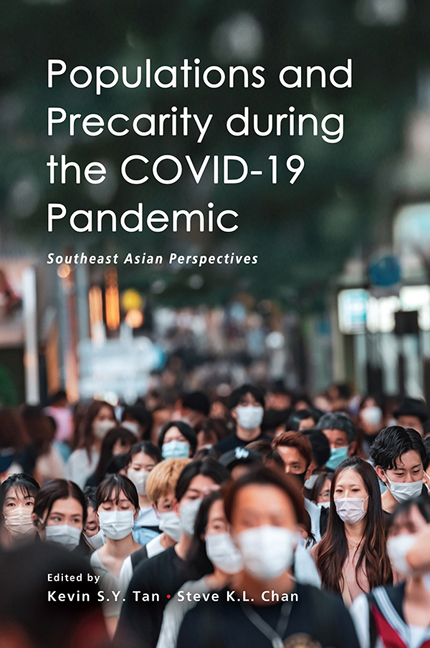Book contents
- Frontmatter
- Contents
- Preface
- About the Contributors
- 1 Introduction: Populations, Precarity and the COVID-19 Pandemic
- 2 Transformation of the Family Structure in Southeast Asia: Trends and Implications
- 3 New Normal, Old Ties: COVID-19’s Social Impact on the Singapore-Johor Bahru Connection
- 4 Unequal Flows: Examining the Factors Surrounding Thai and Vietnamese Labour Migration to South Korea
- 5 Emplacing Multiculturalism: Southeast Asian Migrant Linguistic Acculturation Programmes and Community Building in South Korea
- 6 “Foreign Talent” in Singapore and Some Implications for Schools
- 7 Managing Disaster Risk and Enabling Social Protection in Thailand: Some Lessons from the COVID-19 Pandemic
- 8 Transnational Housing Insecurity: Mobility, Homelessness, and the COVID-19 Pandemic
- 9 Older Persons with Hearing Disabilities in Indonesia: Vulnerability and Demographic Diversity during the COVID-19 Pandemic
- Index
1 - Introduction: Populations, Precarity and the COVID-19 Pandemic
Published online by Cambridge University Press: 01 March 2024
- Frontmatter
- Contents
- Preface
- About the Contributors
- 1 Introduction: Populations, Precarity and the COVID-19 Pandemic
- 2 Transformation of the Family Structure in Southeast Asia: Trends and Implications
- 3 New Normal, Old Ties: COVID-19’s Social Impact on the Singapore-Johor Bahru Connection
- 4 Unequal Flows: Examining the Factors Surrounding Thai and Vietnamese Labour Migration to South Korea
- 5 Emplacing Multiculturalism: Southeast Asian Migrant Linguistic Acculturation Programmes and Community Building in South Korea
- 6 “Foreign Talent” in Singapore and Some Implications for Schools
- 7 Managing Disaster Risk and Enabling Social Protection in Thailand: Some Lessons from the COVID-19 Pandemic
- 8 Transnational Housing Insecurity: Mobility, Homelessness, and the COVID-19 Pandemic
- 9 Older Persons with Hearing Disabilities in Indonesia: Vulnerability and Demographic Diversity during the COVID-19 Pandemic
- Index
Summary
The COVID-19 Pandemic and its Impact
The outbreak of the COVID-19 coronavirus from late 2019 transformed, in many ways, the order of many things in our lives. This pandemic was a major global health challenge in the twenty-first century that has so far been unrivalled in scale and impact. Many lives were lost during the first two years due to its potentially dangerous effects on the human body, particularly among the physically and economically vulnerable. Although Southeast Asia had encountered earlier epidemics such as SARS and MERS in previous years, nothing quite prepared the countries in this region for the social and economic fallout that resulted from not just the disease, but also its corresponding effects on the infrastructural aspects of a country. This included the healthcare system, the education system, the transport system, entertainment industries, and even the capacity for residents of a country to access public spaces. Dubbed a “new normal”, such a challenging experience obviously changed the lives of many in various societies throughout Southeast Asia. Apart from the tragedy of those who succumbed to the pandemic, the ones who survived it will likely carry the burden of coming to terms with its consequences and the changes it has incorporated into everyday living.
Many will recall that during its initial months, governments around the world and even the media tended to regard it as an epidemic that was largely limited to a single country, China. Although it was in China where most researchers today would admit where the COVID-19 coronavirus first emerged, it was presumed that sealing the country's borders might contain the situation. Alarmingly, waves of outbreaks spread in varying intensity around the globe. Its rapid spread in a matter of months to almost every continent via a global network of travel and migration appeared to be inevitable. In the case of South Korea, for example, the city of Daegu recorded a cluster infection in a local church, starting a string of transmissions that would spin out of control. While the traditional approach of testing and contact tracing had initially worked well (Kim 2020), the scale of infection eventually spread everywhere. Finally, it became apparent that the COVID-19 coronavirus would become a full-blown pandemic that would exceed the severity of SARS and MERS, exhibiting similar characteristics to the influenza pandemic of 1918 also known as the ‘Spanish Flu’.
- Type
- Chapter
- Information
- Populations and Precarity during the COVID-19 PandemicSoutheast Asian Perspectives, pp. 1 - 11Publisher: ISEAS–Yusof Ishak InstitutePrint publication year: 2023



